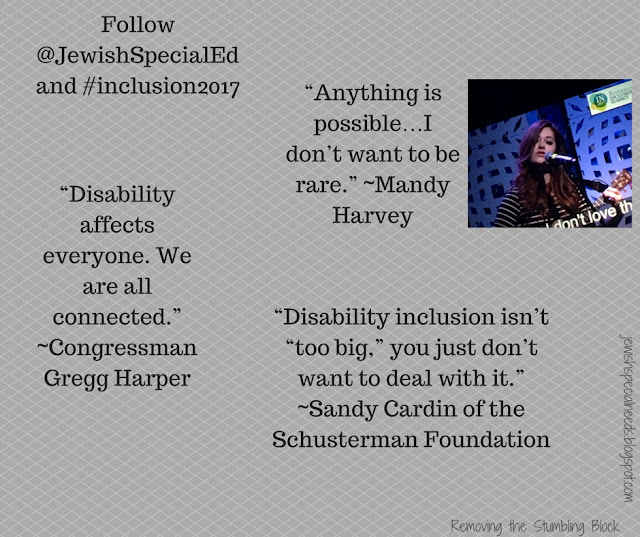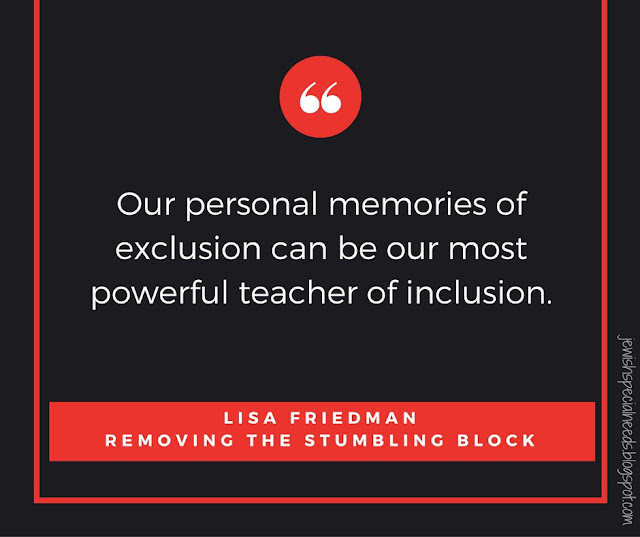It’s exciting to attend a conference focused entirely on
disability inclusion. I am grateful to the leadership of the Ruderman Family
Foundation for convening such an event. Regardless of one’s interest,
connection, professional role, or personal story – being in a space with nearly
1300 other people who are passionate about and committed to inclusion is
inspiring.
Teaching Children to be Inclusive
Someone I follow on Facebook shared the following article: How to Teach Your Child to be an “Includer.” It’s an older article, so I found myself wondering if she was sharing this now because it felt particularly timely, or if it was more of an extension of her own consistent, personal commitment to inclusion. Either way, it resonated with me and had me immediately recalling a post that I wrote which was widely shared: Teach Your Children to Be Accepting of Disabilities.
It’s easy to write blog posts and forget about them. We live in an age of immediacy. Often, if something doesn’t happen in the moment, it won’t happen at all. Instant gratification has become the norm, even when we know that delaying gratification and taking time to process and reflect can be critical. It’s why I pointed out the fact that the article shared a few days ago was written a few months ago. Life moves fast. So even when blog posts “do well” and people read and share widely, a week or two later those same pieces are forgotten; and citing something written a few months or even a year ago can seem outdated.
In this case, I think the message bears repeating and re-sharing: We CAN teach our children to be accepting. We CAN teach our children to be “includers”. And, maybe most importantly, we CAN teach our children to be kind.
Children really will do what we do. We have the power to model for them each and every day. We have the power to teach, through our own actions, how to be kind, compassionate and inclusive.
Celebrating Our Mistakes
This post contain affiliate links.
One of the things I most often discuss when leading inclusion training sessions to be more inclusive is the importance of reframing. We discuss reframing attitudes and reframing language, notions that tend to be fairly easy to understand, even if challenging to consistently apply.
Somehow, for teachers, the place they most get stuck is when it comes to reframing their lesson plans. Even with the right intentions, many teachers find it difficult to consistently design lessons with an eye toward inclusion.
There is also a lot that good teachers take for granted, especially in successful classrooms. I am guilty of this, too. When we have activities and strategies that have been successful, why would we think about changing them? Because to be truly inclusive is to look at every lesson, every activity, every strategy and ask ourselves, "is this inclusive?"
Accommodating isn't the same as inclusion illustrates this concept. It might be "fine" to adapt an activity or add a component to it to make it more successful for specific students, but it is truly inclusive when we reframe the entire activity in a way that makes this addition a seamless part of the whole.
Celebrating Our Mistakes
With thanks to Michelle Steinhart of Temple Israel Center in White Plains, NY for this excellent idea!
As teachers set up classrooms - organizing, labeling and decorating - many are also thinking about systems of behavior management. Most are reading student files and will reach out to begin getting to know their students before the school year even begins. Teachers may learn that a particular student is a "perfectionist", one who struggles to let work go when she thinks she has possibly made a mistake or who will have a meltdown when she does something "wrong". A typical system of behavior management (I am NOT a fan! Read why.) would likely have this student earning tickets or stars each time she is able to hand in an assignment with only one revision.
Reframe the system:
Begin with a classroom discussion of making mistakes and failing as a part of the learning process. Create a system where each student gets to put a marble in the jar when he or she has made a mistake. Just as in other, more traditional systems, the class will earn a reward when the jar is full.
What's different?
- First, students are taught that mistakes are a part of the process of learning and growing.
- Next, the student who struggles to let work go or has a meltdown when he has made a mistake is no longer singled out. Rather, he is celebrated and comes to learn that he has something valuable to contribute to the classroom community.
- Finally, this is a system that celebrates diversity rather than penalizing students for not conforming to an arbitrary set of ideals.
Subscribe to:
Posts (Atom)
You Might Also Like:
Do not publish, curate, sell, post, or distribute all or any part of this blog's content without express permission of the author. You are invited, however, to share links to posts on your webpage, Facebook, Pinterest, Twitter, and other social networking sites.
If you are interested in republishing any Removing the Stumbling Block content on your own blog, in a newsletter, or if you wish to use any content in another educational way, please contact me. I am also available to write unique content for your specific network.





